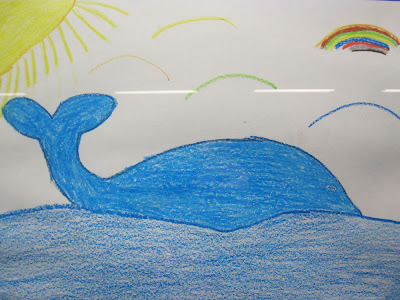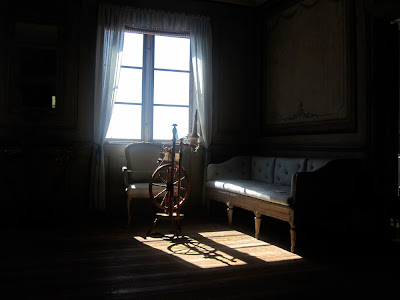Sunday, November 29, 2009
Saturday, November 28, 2009
Thursday, November 26, 2009
Wednesday, November 25, 2009
With Carlos at the Swedish National Museum of Fine Arts (Stockholm)
The sculpture and painting gallery
A very happy lion in a golden frame
Carlos looking at Rodin
A transparent couple, detail from the painting "Venus or Flora" by Jan Massys (1561)
The lips of the critic sealed by Degas, detail from the painting "Portrait of Art Critic Durand Gréville" by Edgar Degas
The golden shower, detail from the painting "Danai receiving the shower of gold" by Adolph Ulrik Wertmiillr (1787)
The amazing moonbow of Caspar David Friedrich, "Landscape with Lunar Rainbow" by Caspar David Friedrich
The unfinished and mysterious coronation painting by Pilo, deatail of "The coronation of Kinf Gustav III" (1782-93) by Carl Gustaf Pilo
Many years after his coronation King Gustav III asked the artist Pilo to do a painting depicting the coronation. The artist refused because he was not present at the coronation, but the king convinced him after some time. Pilo worked on the painting for 10 years. The strange chiaroscuro effects are there partly because the artist experimented with asphalt, in reaction with daylight makes the different layers and retouches visible after a time. But Pilo was the known as the “painter of light” and of course inspired by the light effects in Rembrandts Claudius Civilis that could be seen in Stockholm from 1766 and on. In 1792 Gustav III was shot at the Opera House in a break at a performance and died after a couple of weeks. The artist Pilo died in 1793, he inserted his selfportrait in the painting but never finalized it (Witty synthesis by Cecilia Widenheim).
Posted by Mill Ends Park at 1:38 PM 3 comments
Tuesday, November 24, 2009
Monday, November 23, 2009
Martha Argerich performing Scarlatti's Sonata k. 141 in D minor
Posted by Mill Ends Park at 10:52 AM 0 comments
Saturday, November 21, 2009
Thursday, November 19, 2009
Skansen in the summer
Skansen is the first open air museum and is located on the island Djurgården in Stockholm. It was founded in 1891 by Artur Hazelius and it is the result of a romantic effort to preserve the pre-industrial Sweden. (wikipedia)
Posted by Mill Ends Park at 9:27 PM 1 comments
Sunday, November 15, 2009
Timothy reading "La Maladie de la mort" by Marguerite Duras
Posted by Mill Ends Park at 11:29 PM 0 comments
Saturday, November 14, 2009
Tuesday, November 10, 2009
Monday, November 9, 2009
Saturday, November 7, 2009
Thursday, November 5, 2009
"The Face of Garbo", Roland Barthes (Mythologies)
Garbo still belongs to that moment in cinema when capturing the
human face still plunged audiences into the deepest ecstasy, when
one literally lost oneself in a human image as one would in a
philtre, when the face represented a kind of absolute state of the
flesh, which could be neither reached nor renounced. A few years
earlier the face of Valentino was causing suicides; that of Garbo
still partakes of the same rule of Courtly Love, where the flesh
gives rise to mystical feelings of perdition.
It is indeed an admirable face-object. In Queen Christina, a film
which has again been shown in Paris in the last few years, the
make-up has the snowy thickness of a mask: it is not a painted
face, but one set in plaster, protected by the surface of the colour,
not by its lineaments. Amid all this snow at once fragile and
compact, the eyes alone, black like strange soft flesh, but not in the
least expressive, are two faintly tremulous wounds. In spite of its
extreme beauty, this face, not drawn but sculpted in something
smooth and friable, that is, at once perfect and ephemeral, comes to
resemble the flour-white complexion of Charlie Chaplin, the dark
vegetation of his eyes, his totem-like countenance.
Now the temptation of the absolute mask (the mask of antiquity,
for instance) perhaps implies less the theme of the secret (as is the
case with Italian half mask) than that of an archetype of the human
face. Garbo offered to one's gaze a sort of Platonic Idea of the
human creature, which explains why her face is almost sexually
undefined, without however leaving one in doubt. It is true that this
film (in which Queen Christina is by turns a woman and a young
cavalier) lends itself to this lack of differentiation; but Garbo does
not perform in it any feat of transvestism; she is always herself,
and carries without pretence, under her crown or her wide-
brimmed hats, the same snowy solitary face. The name given to
her, the Divine, probably aimed to convey less a superlative state
of beauty than the essence of her corporeal person, descended from
a heaven where all things are formed and perfected in the clearest
light. She herself knew this: how many actresses have consented to
let the crowd see the ominous maturing of their beauty. Not she,
however; the essence was not to be degraded, her face was not to
have any reality except that of its perfection, which was
intellectual even more than formal. The Essence became gradually
obscured, progressively veiled with dark glasses, broad hats and
exiles: but it never deteriorated.
And yet, in this deified face, something sharper than a mask is
looming: a kind of voluntary and therefore human relation between
the curve of the nostrils and the arch of the eyebrows; a rare,
individual function relating two regions of the face. A mask is but
a sum of lines; a face, on the contrary, is above all their thematic
harmony. Garbo's face represents this fragile moment when the
cinema is about to draw an existential from an essential beauty,
when the archetype leans towards the fascination of mortal faces,
when the clarity of the flesh as essence yields its place to a
lyricism of Woman.
Viewed as a transition the face of Garbo reconciles two
iconographic ages, it assures the passage from awe to charm. As is
well known, we are today at the other pole of this evolution: the
face of Audrey Hepburn, for instance, is individualized, not only
because of its peculiar thematics (woman as child, woman as
kitten) but also because of her person, of an almost unique
specification of the face, which has nothing of the essence left in it,
but is constituted by an infinite complexity of morphological
functions. As a language, Garbo's singularity was of the order of
the concept, that of Audrey Hepburn is of the order of the
substance. The face of Garbo is an Idea, that of Hepburn, an Event.
Posted by Mill Ends Park at 8:40 PM 0 comments









































